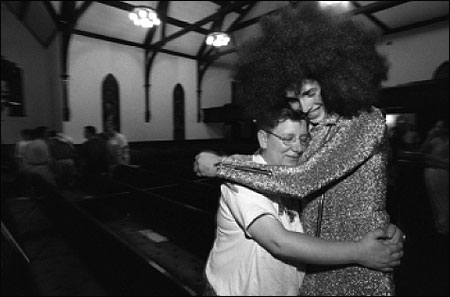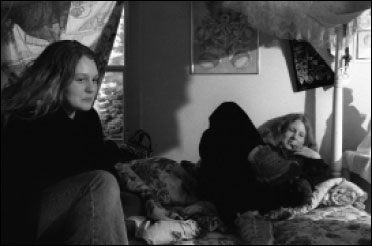
Asher Boisvert, 16, walks to class at Deering High School in Portland, Maine. Because of his different looks and shy character, Asher often gets harassed at school. “I try to think of what I did.” Photo by Gregory Rec/Maine Sunday Telegram.
The assignment unnerved me. My editors wanted me to write about teenagers.
Teens in Portland, Maine had been driven from the city’s parks and downtown streets. Merchants called them “waste products” and blared classical music to scare them off. Police set curfews and arrested those who broke them. Their crime: They were teenagers with no place to go.
“No one listens to us,” they told us. “The media only write about us when we do something bad or get in trouble.”
My editors agreed and decided we needed to rethink the way we covered teens. They asked me to immerse myself in the world of teenagers, to dig deep into their lives and thoughts, to give voice to kids who’d been shunned, feared and often misunderstood. They wanted stories rich in detail and voice that would help the reader understand how being a teenager today is different than 10, 20, 30 years ago.
We decided to tell these stories in an occasional series that would span more than four pages in our Sunday paper. We called the series “On the Verge,” and focused on five themes with which teens said they were most concerned: popularity and cliques; dating and sex; family life; racial and cultural struggles, and the pressure they feel to succeed at an early age.
The Portland Press Herald/Maine Sunday Telegram committed me full time to the assignment and gave me a couple of months to report on each topic. When I started, I worried about how I’d find compelling stories about ordinary kids. Most of my career, I’d reported on kids who had done bad things—teens who raped, killed, vandalized. Now I was looking for those kids who weren’t traditionally newsworthy, the kind of kids who went unnoticed.
“Pretend you’re an archeologist or an alien recording their world,” my editor told me. “Look beyond the clichés and stereotypes.”
Feeling like an alien wasn’t a problem. I was 42, old enough to be the mother of a teenager. How would I get these kids to trust me, to share their lives with me? By talking to teens, to hundreds and hundreds of them. I hung out at rock concerts, schools, music stores, comic shops, school dances, pep rallies. I cruised with high-school girls in their cars, inhaling a lot of cigarette smoke and listening to the teens hoot and holler at “hot boys” walking the streets.
When I found teens who had compelling stories to tell, I gained their trust by spending time with them. I visited them at school, in their homes, shopped with them at the mall, hung out at burger joints with them. They took me to their special places—parks, playgrounds, high school music rooms. I met their friends, listened to their music, went to their dances, learned about their hobbies, what movies, clothes and foods they liked. Easy questions led to the tough ones, questions about what made them angry, sad, elated, scared, excited.
I often asked the teens if I could talk with them in their rooms. I wanted to see what they hung on the walls, whether they had stuffed animal collections, what books they read, what lip gloss or glitter makeup adorned their bureaus. When I talked with Asher Boisvert, a teen with orange spiked hair and a fondness for Kurt Cobain, I sat in his room, surrounded by mounds of clothes, a naked female mannequin, the walls covered with posters of Cobain, a rock singer who killed himself, and grunge rock lyrics. An intercom rested by his bed—it was how the 16-year-old and his parents communicated.
As Asher foraged around on his floor, fidgeting with ties and mechanical tools, he talked about his passion for William S. Burroughs and Shakespeare and his anger about the school kids who ridiculed him for his shy, withdrawn nature. For over a year and a half they jeered at him daily, poking at his hair, taunting him: “Nervous turtle. Nervous turtle.”
On another afternoon, I sat in the peach-painted bedroom of 13-year-old Mary Metevier. Mary’s fuzzy blue slippers dangled from her bunk bed as she giggled and described how her first French kiss was all slimy and gross. She talked about how her first love had dumped her, even though just 24 hours earlier he’d kissed her and told her how beautiful she was. She cried and said it was one of the saddest days of her life.
I met other kids at school dances, kids like seventh graders Robin Dionne and Erin Bell. Rap and disco music blared and bubble gum and peach perfume scented the gym as the girls pointed to a group of kids near the DJ’s stage and explained: “They’re the populars. They rule. They’re hot. We’re not.” Later, when I talked with the girls in their bedrooms, they told me the “populars” could be really mean. They spread nasty rumors about the girls and put them on a list of kids considered too ugly or uncool, too fat or too short.
I talked with teens like Robin and Erin seven days a week for 15 months. They e-mailed me and called me at home. Often, the teens were amazed that I wanted to spend so much time with them and that I actually cared about what they had to say. While gathering their stories, I also had to use different reporting techniques. Girls were usually easy to talk with. They chatted for hours about everything—their divorced parents, abortion, sex, school pressures. Boys often answered my questions with a shy yes or no.
The first boy I tried interviewing was a seventh grader, who had been harassed at school because he was one of the few black students in his class. We talked in the basement of his home while he played with his Hot Wheels. Only 10 minutes had passed when he said: “OK, are we done now?” I groaned. I’d planned to spend about six more hours with him over the next few weeks. The next time we spoke, I asked him to invite his best friend over. The two of them giggled and teased one another and talked about girls and cliques and how they didn’t have many friends. All I had to do was ask an occasional question and they’d rattle on, prodding each other with memories and stories.
I stuck with that routine while talking with many teen boys. When I hung out with them and their friends, I learned plenty by just listening to their banter, their teasing, their memories. I also used a tape recorder during interviews. I dreaded transcribing hundreds of tapes but I wanted to capture how teens talked, how often they stretched their vowels like aaaaawesome when they were excited, mad or happy. While I was writing, their recorded voices often made me laugh or cry or just remember how intensely they felt about their struggles, their decisions or memories that made them really sad.
With every story, every interview, I agonized over what to use and what to keep out of the paper. Often, these kids told me things they’d never told anyone. I found myself editing my notes much more than I would with adult interviews. I routinely told the kids what would be in their stories and deleted details that I felt were too private, too explosive to print. One eighth-grade boy told me that he’d never met his father. When I asked why, he said: “My mom was raped.” I told him I wouldn’t use that information until I’d talked to his mom. Ultimately, I never printed that information because he wasn’t one of the kids I profiled.
Sometimes, parents asked me what their kids and I talked about. Usually, I gave them a general idea of the conversation I’d shared with their son or daughter. But I let their kids fill in the details. After talking with three 16-yearold boys about how agonizing it was to resist having sex, one of their fathers asked me on my way out of his home: “We’re not going to read in the paper that our son is having sex, are we?”
I told him no, I wouldn’t be writing that his son had sex. I wanted to add: “But he’s really close.”
I encouraged teens to let their parents know what we’d been talking about. But sometimes, they weren’t totally honest with their parents about our conversations. For the story about cliques, I profiled a teen girl who was gay and had been sworn at and pushed into lockers at school. Her mom knew she’d been talking to me about peer pressure and her struggles as a gay student. But the mother didn’t know that her daughter had been picked on and pushed around for months at school. She learned about the harassment when my story was published.
The mother cried as she told me: “I can’t believe she didn’t tell me.” I felt badly but I also knew I couldn’t fix family problems or make kids talk to their parents.
Though I always got parental permission to talk with the kids, adults’, parents’ and expert opinions were kept to a minimum. In each of the stories, teen voices dominated. I didn’t want to clutter the stories with mature voices, politically correct quotes that often bog newspapers down and make them boring. These kids had trusted me with their secrets, their fears, their dreams, and I didn’t want to diminish or sugarcoat their stories to make readers more comfortable. I wanted readers to feel like they were in the same room with me as I listened to an 18-year-old girl cry as she talked about aborting a baby when she was just 14. I wanted people to feel the sadness of teens who were torn apart by their parents’ divorce. I wanted readers to care about these kids and what they had to say. I usually interviewed teens three and four times, spending at least six to eight hours with them, and sometimes up to a dozen or more hours. My editors never blinked about the time commitment—especially after the first article about cliques and peer pressure appeared.
We received more than 100 letters and e-mails from readers, who thanked us for reporting on teens in such a dramatic, novel way. Many of our readers said they had no idea being a teen today was so stressful. Yet our series helped them to see that even though teenagers are dealing with the same old pressures—sex, drinking, drugs and grades—today they are moving at warp speed. The teens we portrayed helped adults understand that their worlds are bigger and broader and spin 24 hours a day, seven days a week. They’re wired to computers, beepers and cell phones. On TV, teens see and hear sex, sex, sex an average of 14,000 times a year. And they’re maturing faster and experimenting with sex sooner. They are expected to excel, succeed and have their futures mapped out by eighth grade. And they’re growing up in homes where broken and blended families are commonplace.
Throughout the five-part series, teachers in middle schools, high schools and colleges used our articles in their classrooms to open up discussions about sex, cliques, name-calling, divorce and race. Parents also said the stories gave them an opportunity to talk to their kids about topics they’d been afraid to bring up around the dinner table. Hits on our teen Web site, where the stories are archived, tripled from 20,000 page views to 60,000 each month.
Teens eagerly read the stories. They said they related to the emotions and experiences of the kids I profiled. It comforted them to know they weren’t alone in their anguish over fitting in, struggling with sexual urges or finding peace in a family that was fractured and “messed up.” And the teens were thrilled that someone cared enough to listen to them.
“Thank you for finally writing about teens and their lives,” one teenage girl wrote. “It means a lot to know adults notice that we exist in a manner that isn’t negative.”
The stories also changed the way the community looked at teens. The Portland City Council invited high-school students to sit on an advisory board to offer ideas and solutions on teen issues. Readers also reached out to teens who needed help. They offered support, money and encouragement to kids who lived in troubled or poor families. One of those teens, Tom Pelletier, received more than 50 calls and more than $2,000 in donations after I reported that he’d been accepted into MIT. He’d gotten into the prestigious school despite growing up in a home with an abundance of abuse, alcohol and poverty.
Not all the feedback on the series was positive. “The stories made me uncomfortable,” one woman told the newspaper. “You should talk to more parents, adults,” one father advised. “These kids are just teenagers. You shouldn’t rely just on their words and emotions.”
We decided otherwise. The stories were compelling because we relied on teens’ voices and experiences. They weren’t clichéd, trite tales that had been reported dozens of times before. These stories were raw, real, unvarnished portraits of kids who’d been largely ignored. We might have made some of our adult readers uncomfortable, but we promised teens we’d listen to them and tell their stories.
It felt good to keep that promise.

Dressed in gown and wig, 17-year-old Brad Chapman gets a hug from one of his “mummies,” Jess Maurer, after his performance with the Maine Gay Men’s Chorus. Photo by
Gregory Rec/Maine Sunday Telegram.

Jolene Sinclair (left) and Nichole Ryder hang out in Nickie’s bedroom. “They live in a community where it’s survival of the fittest,” says Michael Hutton, who works at a Christian teen center where the girls occasionally visit. “There are a lot of things missing in their lives.” Photo by Gregory Rec/Maine Sunday Telegram.
Barbara Walsh, who works for the Portland Press Herald/Maine Sunday Telegram as a projects and general assignment writer, shared a staff Pulitizer Prize for General News Reporting in 1988 when she worked for The Lawrence (Mass.) Eagle-Tribune.



